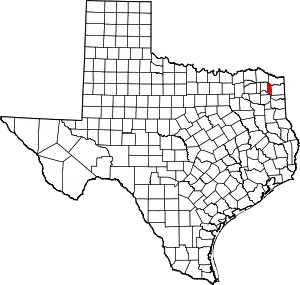Lone Star, Texas
Lone Star is a city in Morris County, Texas, United States. Its population was 1,581 at the 2010 census.
Lone Star, Texas | |
|---|---|
 Location in Morris County and the state of Texas. | |
| Coordinates: 32°56′35″N 94°42′29″W | |
| Country | United States |
| State | Texas |
| County | Morris |
| Area | |
| • Total | 2.00 sq mi (5.18 km2) |
| • Land | 1.98 sq mi (5.12 km2) |
| • Water | 0.02 sq mi (0.05 km2) |
| Elevation | 348 ft (106 m) |
| Population (2020) | |
| • Total | 1,993 |
| • Estimate (2019)[2] | 1,482 |
| • Density | 749.24/sq mi (289.22/km2) |
| Time zone | UTC-6 (Central (CST)) |
| • Summer (DST) | UTC-5 (CDT) |
| ZIP code | 75668 |
| Area code | 903 |
| FIPS code | 48-43684[3] |
| GNIS feature ID | 1340390[4] |
| Website | www |
Geography
Lone Star is located at 32°56′35″N 94°42′29″W (32.943105, –94.708017).[5] According to the United States Census Bureau, the city has a total area of 2.0 square miles (5.2 km2), of which 0.50% is covered by water.
Demographics
| Race | Number | Percentage |
|---|---|---|
| White (NH) | 856 | 61.14% |
| Black or African American (NH) | 287 | 20.5% |
| Native American or Alaska Native (NH) | 8 | 0.57% |
| Asian (NH) | 12 | 0.86% |
| Pacific Islander (NH) | 2 | 0.14% |
| Some other race (NH) | 100 | 0.21% |
| Mixed/multiracial (NH) | 61 | 4.36% |
| Hispanic or Latino | 171 | 12.21% |
| Total | 1993 |
As of the 2020 United States census, 1,993 people, 598 households, and 628 families were residing in the city.
Education
Most of the city of Lone Star is served by the Daingerfield-Lone Star Independent School District. A small portion also attend schools in the Hughes Springs ISD.
References
- "2019 U.S. Gazetteer Files". United States Census Bureau. Retrieved August 7, 2020.
- "Population and Housing Unit Estimates". United States Census Bureau. May 24, 2020. Retrieved May 27, 2020.
- "U.S. Census website". United States Census Bureau. Retrieved January 31, 2008.
- "US Board on Geographic Names". United States Geological Survey. October 25, 2007. Retrieved January 31, 2008.
- "US Gazetteer files: 2010, 2000, and 1990". United States Census Bureau. February 12, 2011. Retrieved April 23, 2011.
- "Explore Census Data". data.census.gov. Retrieved May 21, 2022.
- https://www.census.gov/
- "About the Hispanic Population and its Origin". www.census.gov. Retrieved May 18, 2022.
This article is issued from Wikipedia. The text is licensed under Creative Commons - Attribution - Sharealike. Additional terms may apply for the media files.
